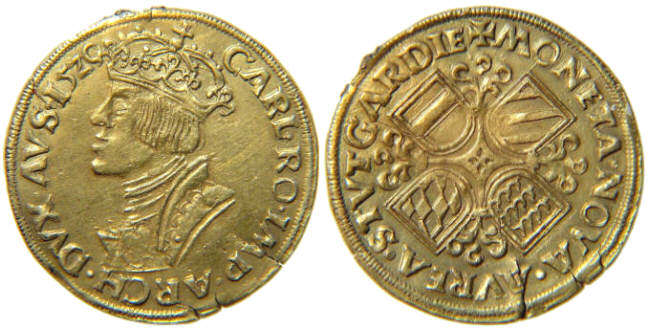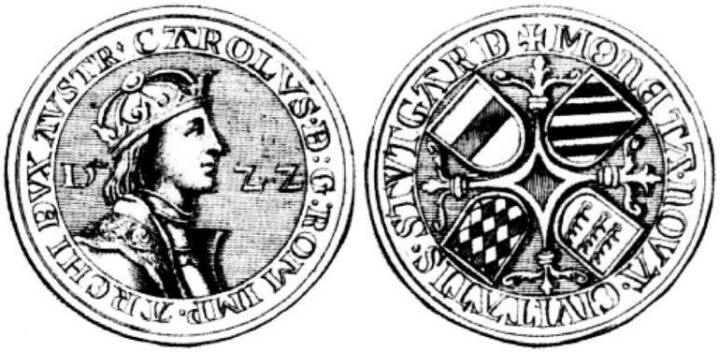|
Duchy of Württemberg, 1520-1534 under Habsburg's occupation
The ruthless and dissolute Duke Ulric of Württemberg had already been banned when he attacked the imperial city of Reutlingen and annexed it. The Swabian League was forced to proceed against him in 1519. Ulrich had to flee the country and the Swabian League relinquished Württemberg to emperor Charles V in return for the restitution of war expenses. In early 1522 Württemberg changed hands again when Charles vested his brother Archduke Ferdinand with the sovereignity of the Austrian countries. Only in 1534 did Ulrich recover the country as an Austrian afterfief.
Stuttgart, the only mint in Württemberg since 1423, became the residential capital in 1495.
|
 Goldgulden 1520, Stuttgart. Ø 23 mm. Schulten 3686; Klein/Raff 66
Goldgulden 1520, Stuttgart. Ø 23 mm. Schulten 3686; Klein/Raff 66
Obv.: CARL·RO·IMP·ARCH·DVX·AVS·1520 - crowend bust.
Rev.: +MONETA·NOVA·AVREA·STVTGARDIE
lily-cross and arms from Austria, Burgundy, Württemberg (three deer antlers) and Teck (rombs).
|
By definition, the obverse of a coin (obv.) identifies the owner of the mint right. For this coin, the legend on one face might suggest Stuttgart to possess the mint right and this face would then be the obverse. The reverse of the coin (rev.) would then have to show the emperor's title and bust as symbol of his immediate authority. Instead, the coat of arms indicate Habsburg and the Duchy of Württemberg, not Stuttgart, which proves the young emperor to be the owner of the mint right.
These golden gulden of 1520 must have been minted in large numbers. Six different dies are known up to now. However, the coins are scarce today, very likely because many guldens were withdrawn form circulation and melted down on Ulrich's return to Württemberg. [Klein/Raff]
|
 Guldengroschen 1522, Stuttgart. Ø 41 mm Schulten 3688; Dav.9959.
Guldengroschen 1522, Stuttgart. Ø 41 mm Schulten 3688; Dav.9959.
Obv.: CAROLVS·D:G.ROM IMP·ARCHIDVX AVSTR·
crowned bust of the young emperor between date.
Rev.: +MONETA·NOVA·CIVITATIS·STVTGARD
lily-cross and arms from Austria, Burgundy, Württemberg and Teck.|
This coin is a product of phantasy copied on the gold gulden of 1520. The copperplate print in Köhlers Münzbelustigungen IX,217 (1729-1750) was not manufactured on an original coin, as indicated, but is a faithful copy taken from Bernd Arendts "Münzbuch". [Klein/Raff]
|
|
The arms of Württemberg (three deer antlers) emerge for the first time on a coin issued by Habsburg. In 1534 Ulric got his duchy back as an Austrian fief while Charles's brother Archduke Ferdinand retained the title "Duke of Württemberg". The tenure was to return to Habsburg, should the House of Württemberg become extinct. Ulrich's descendants were able to regain imperial immediacy in 1599: emperor Rudolf II bestowed the duchy as imperial fief while retaining the formal right to the title and to Württemberg's coat of arms as well as the right to bequeath the imperial fief. This is how the Württemberg antlers got into the Habsburg coat of arms, which in later times showed up to 16 fields on some Habsburg thalers.
|
Duke Ulric was the sovereign minting before and after the Habsburg occupation of Württemberg.
Ref.: Klein, U. / Raff, A., Die Württembergischen Münzen von 1374-1873, Bd.1, 1993
|


 start page
start page